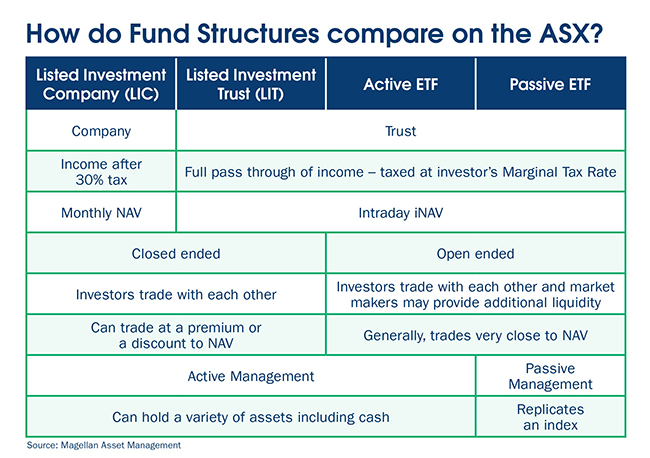Active and passive ETFs – what’s the difference?

Active and passive ETFs – what’s the difference?
Emma Kirk
Key Account Manager, Magellan Asset Management Limited
Exchange Traded Funds (ETFs) are a simple way for investors to gain access to a wide range of asset classes. They are open-ended funds whose units trade on the Australian Securities Exchange (ASX), just like an ordinary listed security. They enable investors to gain access to a portfolio of shares in one easy transaction – either online or through a stockbroker or financial adviser.
Passive ETFs have existed since 1993 when State Street launched the SPDR S&P 500 ETF in the US. Passive ETFs typically track an index (such as the S&P 500 index) and the portfolio is updated regularly (generally quarterly) to reflect changes in the reference index.
Active ETFs, where an investment manager is actively managing a portfolio of securities, have existed globally for some time. However, there have been few choices available to investors as investment managers have been reluctant to publish their portfolios daily. In Australia, Active ETF issuance started to evolve in early 2015 when issuers and regulators agreed on a portfolio disclosure regime that balanced the needs of investors who want to know what they are investing in with the protection of the investment manager’s intellectual property (its portfolio holdings an active portfolio decisions).
Structurally, Passive ETFs and Active ETFs are similar, but they also have some differences that are important for investors to understand.
What are the similarities?
Structure
In Australia, both Passive and Active ETFs are generally registered managed investment schemes, a type of ‘unit trust’, that trades on the ASX in the same way that a share in a company trades on ASX. Like any share or unit traded on the ASX, investors can buy or sell units in the ETF from each other on the ASX.
Liquidity
To ensure there is efficient trading in the secondary market of ETF units and with the objective of having the trading price track the underlying net asset value, ETF issuers put in place additional liquidity arrangements. As ETFs are open-ended funds and can continuously issue and redeem units, they are able to facilitate these liquidity arrangements. Passive ETFs issuers largely outsource the provision of liquidity to third-party market makers such as investment banks. Active ETF issuers either follow the same market making model as Passive ETFs - or opt to have the ETF provide the liquidity.
Transparency
Investors have transparency as to the value of the underlying fund and the composition of its portfolio through regular disclosure provided on the ASX and the ETF issuer’s website. The level of portfolio disclosure will generally depend on whether the ETF is a Passive ETF or an Active ETF and, in the case of the latter, what has been agreed with the ASX.
Passive ETFs will either provide an iNAV per unit and/or the full portfolio comprising names and weights of the investments as well as monthly fund fact sheets. Active ETFs will generally provide daily net asset value and iNAV per unit, monthly fund fact sheets and a full portfolio comprising names and weights of the investments on either a monthly or quarterly basis.
Taxation
Being unit trusts, both Passive and Active ETFs allow a full pass-through of income such as dividends, franking credits, capital gains and discounted capital gains income, and provide investors with the ability to manage their own tax affairs.
What are the differences?
Types of Investments
With an Active ETF, a portfolio manager will undertake stock research to determine which underlying securities or stocks to hold and in what percentages. They will then actively manage weightings of the stocks depending on stock valuations, industry trends and views on macroeconomics. They can also hold cash to manage the overall risk of the portfolio and also to take advantage of opportunities when markets move.
A Passive ETF tracks an index. This can be over a broad-based stock market index, a sector index, custom-built indices or indices comprising fixed income, credit, commodities and currency. They can either fully replicate an index by buying all the securities that make up the index - or they can be optimised by buying the securities in an index that provides the most representative sample of the index based on correlations, exposure and risk.
Physical ETFs attempt to track their target indices by holding all, or a representative sample, of the underlying securities that make up the index whereas Synthetic ETFs rely on derivatives such as swaps to execute their investment strategy instead of physically holding each of the securities in an index.

How many ETFs are available on the ASX?
As at the end of January 2019, there were 185 Active and Passive ETFs available on the ASX with over $41 billion in assets under management.*
How do I access ETFs?
You can access both Passive and Active ETFs on the ASX via your online share trading account or through your adviser. You will need to know the ASX code that relates to the ETF.
Leveraged offers lending on a diverse range of ETFs. To learn more about gearing into ETFs, please contact your adviser, Leveraged Relationship Manager or call Leveraged on 1300 307 807.
This material has been prepared by Magellan Asset Management Limited (‘Magellan’) for general information purposes and must not be construed as investment advice. This material does not constitute an offer or inducement to engage in an investment activity nor does it form part of any offer or invitation to purchase, sell or subscribe for in interests in any type of investment product or service. This material does not take into account your investment objectives, financial situation or particular needs. You should read and consider any relevant offer
documentation applicable to any investment product or service and consider obtaining professional investment advice tailored to your specific circumstances before making any investment decision. This material and the information contained within it may not be reproduced or disclosed, in whole or in part, without the prior written consent of Magellan. Any trademarks, logos, and service marks contained herein may be the registered and unregistered trademarks of their respective owners. Nothing contained herein should be construed as granting by implication, or otherwise, any licence or right to use any trademark displayed without the written permission of the owner.
Statements contained in this material that are not historical facts are based on current expectations, estimates, projections, opinions and beliefs of Magellan. Such statements involve known and unknown risks, uncertainties and other factors, and undue reliance should not be placed thereon. Additionally, this material may contain “forward‐looking statements”. Actual events or results or the actual performance of a Magellan financial product or service may differ materially from those reflected or contemplated in such forward‐looking statements.
Certain economic, market or company information contained herein has been obtained from published sources prepared by third parties. While such sources are believed to be reliable, neither Magellan or any of its respective officers or employees assumes any responsibility for the accuracy or completeness of such information. No person, including Magellan, has any responsibility to update any of the information provided in this material.
Things you should know
Gearing involves risk. It can magnify your returns; however, it may also magnify your losses. Issued by Leveraged Equities Limited (ABN 26 051 629 282 AFSL 360118) as Lender and as a subsidiary of Bendigo and Adelaide Bank Limited (ABN 11 068 049 178 AFSL 237879). Information is general advice only and does not take into account your personal objectives, financial situation or needs. The views of the author may not represent the views of the broader Bendigo and Adelaide Bank Group of companies (“the Group”). This information must not be relied upon as a substitute for financial planning, legal, tax or other professional advice. You should consider whether or not the product is appropriate for you, read the relevant PDS and product guide available at www.leveraged.com.au, and consider seeking professional investment advice. Not suitable for a self-managed superannuation fund.
Examples are for illustration only and are not intended as recommendations and may not reflect actual outcomes. Past performance is not an indication of future performance. The information provided in this document has not been verified and may be subject to change. It is given in good faith and has been derived from sources believed to be accurate. Accordingly no representation or warranty, express or implied is made as to the fairness, accuracy, completeness or correction of the information and opinions contained in this article. To the maximum extent permitted by law, no entity in the Group, its agents or officers shall be liable for any loss or damage arising from the reliance upon, or use of the information contained in this article.



